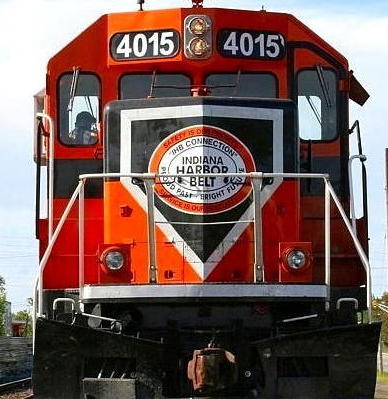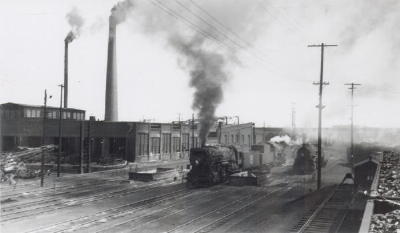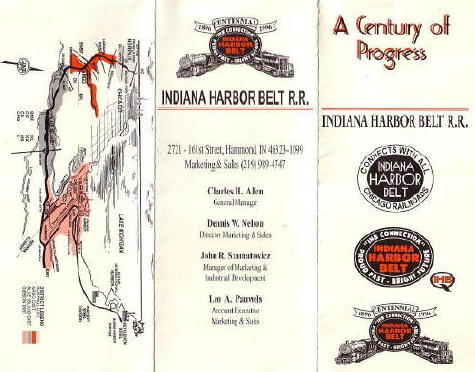


The Indiana Harbor Belt as we know it today was formed in 1907. The Chicago Junction Railway, a New York Central affiliate, had leased the East Chicago Belt Railroad and the Terminal Railroad in 1898, and had bought the Chicago, Hammond & Western Railroad in 1896. In October of 1907, the ECB's lease was dissolved, and it then acquired the CJ's interest in CH&W and assumed control of the Terminal Railroad as well. The new company was named the Indiana Harbor Belt Railroad. Although not a signatory, the New York Central provided the financial backing and quietly orchestrated the entire transaction, reserving trackage rights over all routes of the new railroad.
(For more on IHB's predecessor roads, see the bottom of this page.)
By this time, the CH&W extended from the Standard Oil refinery in Whiting, Indiana, to Franklin Park, Illinois, where it connected with the Milwaukee Road. The ECB had a route running from a connection with CH&W at the Illinois-Indiana line to Grasselli in East Chicago, Indiana, site of a large chemical plant. The Terminal Railroad originated at Argo (near McCook, Illinois), where it connected with CH&W, and ran east to the Chicago stockyards. NYC placed ownership of the IHB in the hands of two line-haul roads that it controlled: the Michigan Central and the Lake Shore & Michigan Southern. Each owned 50% of the Harbor. In 1911, however, two major connections to the west, the Milwaukee Road and the Chicago & North Western, bought 20% stakes in the IHB. Then in 1914, NYC merged LS&MS. So by 1915, IHB ownership consisted of 30% New York Central, 30% Michigan Central, 20% C&NW and 20% Milwaukee, thus giving NYC in effect a 60% controlling interest. This ownership arrangement would last for many years.
Shortly after the Harbor was formed, NYC leased to IHB the northernmost seven miles of the Chicago, Indiana & Southern. The CI&S originated at the Indiana Harbor lakefront and ran south through Gibson, where it crossed what is now the IHB main, to the Nickel Plate crossing at Osborn. The segment extending from the lakefront to Highland (crossing of the Erie Railroad) a few miles south of Osborn was leased to the Harbor. The IHB has operated it ever since and is now known as the Kankakee Line. South of Highland, CI&S extended to Danville, Illinois, and ultimately via connection with another NYC property to Cairo at the southern tip of Illinois. Traffic on the Harbor's portion was heavy enough to warrant double-tracking, which exists to this day. The Harbor then expanded its reach into the steel-making area along the lakefront by obtaining trackage rights from the Elgin, Joliet & Eastern and the Pennsylvania Railroad. The EJ&E and the Pennsy in turn were granted rights over IHB, enabling the J to reach Franklin Park and PRR to access the stockyards via the Terminal line. IHB also acquired a branch line across Wolf Lake on the Illinois-Indiana border to PRR's Colehour Yard at the lakefront, and in addition extended the ECB track further east to reach the Cudahy packing plant in East Chicago.
A final piece of the Harbor puzzle was the another NYC venture known as the Gary & Western, built around the time U.S. Steel's enormous Gary Works was constructed. It extended east from Ivanhoe on the west side of Gary, Indiana, running through the central part of the city on an elevation. On Gary's east side it turned north toward the steel mill and then headed east again near the lakefront. Here, it connected to a segment of a Chicago, Indiana & Southern line that ran to what is now Burns Harbor, Indiana. Both the G&W and the CI&S route were owned by New York Central, but the Harbor operated them. They served several industries in Gary, and also hauled sand and other bulk commodities from the Burns Harbor area. When CI&S was folded into the New York Central System in 1914, the Harbor leased the G&W/CI&S route from the Central.

What is now the east-west IHB main line between Gibson and Calumet Park junctions belonged to Michigan Central during these years, and MC had built Gibson Yard--a huge double hump facility--west of the MC / CI&S crossing at Gibson Junction. The Harbor was granted use of the yard and became responsible for all switching. IHB was also granted access to the Chicago, Indiana & Southern's shops, roundhouse and coaling tower between the east end of the yard and the junction. When CI&S was folded into the NYC in 1914, the Harbor inherited those facilities. To access the shops area more easily from their main line west of Calumet Park, IHB secured trackage rights over MC to Gibson in 1913, and with the downgrading of the MC in the Calumet area by NYC and Penn Central after 1960, this segment of trackage was formally leased to the Harbor.
As industrial activity increased in the Calumet area after World War I, the Harbor decided that it needed more classification capacity. The result was a new hump yard built near Blue Island in 1926. Blue Island Yard had a 44-track classification yard and large facility for loading and servicing ice-cooled refrigerator cars. The yard became a departure point for many of NYC's eastbound road freights, while Gibson remained the terminus for westbounds. The eastbounds of course used the Harbor main to reach Gibson, where they either continued east on the MC main or headed north on the former CI&S to access NYC's ex-LS&MS Water Level Route at Indiana Harbor.
The Harbor remained a busy place during the lean years of the 1930s, and saw even greater activity in the 1940s as World War II placed great demands on the railroads. Like most terminal and switching roads, the Harbor dieselized early, replacing its worn out steam engines with NW2 switchers. By 1951, the last steamer had dropped its fire, but the 1950s also saw a more important development: traffic volume began a gradual decline. Livestock and ice-cooled perishable shipments had been Harbor mainstays, but by 1965 they had virtually disappeared. The The growth of intermodal traffic did nothing to help, since it simply reduced the number of box cars and similar shipments. Intermodal trains from a Class I would be off-loaded and transferred by truck to a terminal of another Class I, thus precluding IHB from performing its usual transfer work. Indeed, the Harbor's original purpose of collecting, classifying and delivering rail cars between the connecting railroads began to slowly fade. Class I roads steadily increased their practice of "pre-blocking" trains at outlying locations and running them directly to other Class I's in Chicago. But since IHB's belt line around Chicago provided an efficient connection between Class I terminals, IHB gained new life as a conduit for many of these run-through trains, and gained new income in the form of trackage rights fees and joint-facility agreements.
Consequently, the Harbor is now more of a common-use facility with run-throughs a frequent occurrence. Today, only about one in every four trains on the Harbor's main line is an IHB movement, but since many trains of the Class I roads still head for Blue Island and Gibson yards, they remain very busy locations. Several Class I classification yards of the past are now predominantly intermodal terminals, so Blue Island has emerged as a major destination for general merchandise traffic of the Class I roads.
Since Blue Island was sufficient to handle general merchandise traffic, the lean years of the late '70s and early '80s saw the closing of Gibson Yard as a major hump facility. However, it did not remain shut down for long. It rose from the dead in the 1990s as a dedicated auto rack facility. It turned out to be the right location for eastern and western roads to interchange automobile and truck shipments. Today's Gibson Yard is only one-third the size of the old one (and of course the humps are long gone), but it is an important part of the Chicago rail network. IHB performs all switching and transfer services at Gibson.

In 1961, the Chicago & North Western sold its 20% stake in the Harbor, and in the financial maneuvering that followed, New York Central reduced its controlling share of the IHB to 51%, while Milwaukee Road increased its share to 49%. In 1968, Penn Central inherited NYC's share, and with the collapse of PC in 1970, Conrail would assume this controlling interest in 1976. Meanwhile, the demise of the Milwaukee in the late '70s led to the Soo Line and subsequently Canadian Pacific acquiring the minority interest. When Conrail was broken up in 1999, some of its property was retained by Conrail Shared Assets instead of being parcelled out between NS and CSX. Included was the 51% controlling interest in the Harbor. However, Conrail SA's seats on IHB's board of directors are occupied on a 50-50 basis by NS and CSX executives, with the stipulation (required by the Surface Transportation Board ruling) that they are to act in unison on any issue coming before the board. Any disagreements between them must be worked out in advance of a vote so that the 51% control of IHB is retained. Failure to do so would require binding arbitration which neither NS nor CSX wants. Thus for anything to get done, the NS and CSX board members must act together.
The Harbor is now a smaller railroad. Ironically, the East Chicago Belt--the railroad that began it all back in 1907--has been abandoned for all but a mile of its length. And except for a short distance near Argo, the stockyards branch was torn up in the 1980s, with IHB now using trackage rights on a parallel Belt Railway line. Only a couple of miles of the Gary & Western remain, but the Harbor still reaches Burns Harbor on trackage rights over NS's ex-NYC main line. The Port of Indiana was built near the Burns Harbor inlet in the early 1970s, and IHB now switches the facility. The port experienced rapid growth in the 1990s, with nearly 100 ships per year docking there, as well as several hundred barges. Most of the ships use the St.Lawrence Seaway, which is open about nine months of the year. In addition, IHB serves some of the steel-related industries in the area and a large grain elevator. At least one train a day runs out to the port and back.
When Conrail was carved up in 1999, the Surface Transportation Board stipulated that nothing would be done in the next five years to alter the Harbor's status as a quasi-independent railroad. This grace period expired in July, 2004, and thus far nothing has happened that would threaten the status quo.
Let's hope that continues.
The East Chicago Belt Railroad was a switching line built in 1896 from a connection with the Chicago, Hammond & Western at the Illinois-Indiana border and ran east to a chemical plant near Grasselli in East Chicago, a distance of about six miles. The Michigan Central and Lake Shore & Michigan Southern were its backers. ECB was later leased by the Chicago Junction Railway, a road controlled by the New York Central that operated in the stockyards area of Chicago. The CJ's president was Chauncey Depew, an NYC executive, and it was during his tenure that ECB purchased CJ's ownership stake in CH&W. ECB's name was changed in 1907 to Indiana Harbor Belt Railroad.
The Terminal Railroad was a ten-mile line constructed by Michigan Central in 1897 from Argo, where it connected with Chicago, Hammond & Western, east to the stockyards in central Chicago. In 1907 it became the property of the newly formed Indiana Harbor Belt Railroad. With the closure of the stockyards in 1972, the line was gradually cut back to a small segment at Argo.
The Hammond & Blue Island ran from Whiting, Indiana, through Hammond to Blue Island, Illinois, a distance of 14 miles. Built in the mid-1890s, H&BI provided a connection from railroads along the lakefront in Whiting--and from the oil refineries in that area--to Michigan Central in Hammond and the Rock Island at Blue Island. In 1896, it was acquired by the Chicago, Hammond & Western.
Chartered in April, 1896, the Chicago, Hammond & Western ran 39 miles from the refinery area in Whiting through Hammond to Franklin Park, Illinois, and a connection with the Milwaukee Road. It was originally backed by the G.H. Hammond meatpacking firm, whose founder gave the city of Hammond its name and who pioneered in the development of ice-cooled refrigertor cars. An English syndicate acquired the road and then bought the H&BI to secure the Whiting end of the route.
Before beginning the western end of the route from Blue Island to Franklin Park, CH&W discovered that the Chicago & Calumet Terminal railroad had already begun construction of a belt line that would roughly parallel its own tracks as far as McCook, Illinois, about half way to Franklin Park. The C&CT was a terminal road chartered in 1890 and backed by Wisconsin Central, then under the control of Northern Pacific. To avoid duplication and unnecessary expense, CH&W and C&CT negotiated a mutual trackage rights pact. C&CT granted CH&W rights from Blue Island to a point just north of McCook known as Superior, and in turn CH&W granted rights over its projected route from Superior to Franklin Park. Once agreement was reached in 1896, CH&W completed the Superior-Franklin Park segment a year later. This segment proved to be important for both roads, for it provided connections to the Chicago, Burlington & Quincy at LaGrange, the Chicago & North Western at Bellwood and of course the Milwaukee. In 1897 the C&CT was folded into the Chicago Terminal Transfer railroad, and with the CTT's fall into receivership in 1910, the line was purchased by the Baltimore & Ohio and renamed Baltimore & Ohio Chicago Terminal.
In 1898, CH&W was puchased by the Chicago Junction, and in 1907 the East Chicago Belt, with New York Central financial backing, acquired the CJ's stake, thus creating the Indiana Harbor Belt of today. The agreement reached by CH&W and C&CT persists to the present day. From Blue Island to Superior, the track and infrastructure are owned by B&OCT, now a CSX subsidiary, while ownership north from Superior to Franklin Park belongs to the Harbor.
CI&S was a New York Central-controlled route that ran south from the lakefront in Indiana Harbor to Danville, Illinois. It was constructed in 1901 as the Indiana Harbor Railroad, and in 1906 the name was changed to Chicago, Indiana & Southern. At Danville, it connected with another NYC route to reach Cairo and the area known as "Little Egypt" at the southern tip of Illinois. Consequently, it came to be known as the "Egyptian Line." In its early days, it primarily hauled coal from southern Illinois mines to the steel industries in East Chicago. Shortly after the Indiana Harbor Belt was formed in 1907, NYC leased to IHB the seven-mile segment of CI&S that extended from its northern terminus at Indiana Harbor to Highland, Indiana. The lease arrangement still holds, and the route is now known as the Kankakee Line. In 1914, NYC merged the CI&S. Today, the Harbor lease is held by Norfolk Southern, who inherited the CI&S trackage south of Osborn.
CI&S had a second route running east from Indiana Harbor to Burns Harbor, Indiana. The western half of this line was torn up circa 1904 to make way for the U.S. Steel plant in Gary. To connect its eastern half with the line to Danville, the Gary & Western was built through Gary. The G&W and CI&S routes were operated as a single railroad by IHB.
--Bill Gustason
Sources:
Blaszak, M., "Change on the Harbor," Trains magazine, March, 1986.
Simons, R. and Parker, F., Railroads of Indiana, Indiana University Press, 1997.
Interview with Chuck Allen, former general manager of IHB, in Machines of Iron video, Indiana Harbor Belt
and Belt Railway
of Chicago.
Harlow, A., The Road of the Century, Creative Age Press, 1947.
E-mail correspondence with Keith Robbins, Joseph Santucci, Ralph Eisenbrandt and Bob Zelisko.